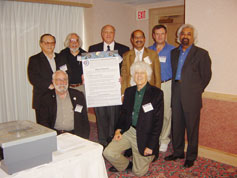
Handy Links
SLAC News Center
SLAC Today
- Subscribe
- Archives: Feb 2006-May 20, 2011
- Archives: May 23, 2011 and later
- Submit Feedback or Story Ideas
- About SLAC Today
SLAC News
Lab News
- Interactions
- Lightsources.org
- ILC NewsLine
- Int'l Science Grid This Week
- Fermilab Today
- Berkeley Lab News
- @brookhaven TODAY
- DOE Pulse
- CERN Courier
- DESY inForm
- US / LHC
SLAC Links
- Emergency
- Safety
- Policy Repository
- Site Entry Form

- Site Maps
- M & O Review
- Computing Status & Calendar
- SLAC Colloquium
- SLACspeak
- SLACspace
- SLAC Logo
- Café Menu
- Flea Market
- Web E-mail
- Marguerite Shuttle
- Discount Commuter Passes
-
Award Reporting Form
- SPIRES
- SciDoc
- Activity Groups
- Library
Stanford
Around the Bay
Mapping the Digital Divide
 Les Cottrell has spent more than a decade measuring the differences in access to
Internet services that exist between developed and developing countries. Most
recently, he organized a session on the digital divide during last April's American Physical Society meeting, and has submitted a paper on the subject to an international conference that will be held in Kathmandu, Nepal, in December.
Les Cottrell has spent more than a decade measuring the differences in access to
Internet services that exist between developed and developing countries. Most
recently, he organized a session on the digital divide during last April's American Physical Society meeting, and has submitted a paper on the subject to an international conference that will be held in Kathmandu, Nepal, in December.
Cottrell, of SLAC's Scientific Computing and Computing Services Group, began his research on Internet performance in 1994, when physicists at the lab complained to him whenever the Internet performed poorly. "We didn't know why it happened, so we started to make measurements," he says. In 2000, encouraged by the International Committee on Future Accelerators, he switched his focus to quantifying the digital divide across countries, concretely studying which countries have connectivity problems.
Cottrell's group, working with collaborators from Fermi National Accelerator Laboratory, Georgia Tech and the National University of Science and Technology in Pakistan, developed a program called Ping End-to-end Reporting (PingER). PingER uses "pings," short messages sent from a computer to a distant host, to gauge the performance of international networks. The program measures how long it takes for the "ping" to go and come back and how frequently the messages get lost; these measurements give a good idea of the quality of the networks.
Knowing the network quality of a country is also essential to decide if it can participate in international research projects. Cottrell says that improving the network connectivity for developing countries is a basic step towards improving their educational and research systems, as well as their economies.
"In today's information age, countries that want to catch up, or even keep up, need good network infrastructures, good education to enable the population and good leadership that recognizes this and can make it happen," he says.
—Mar�a Jos� Vi�as, SLAC Today, May 30, 2007
Above photo: Les Cottrell (bottom right) with the speakers at the Digital Divide Seminar, held during the last meeting of the American Physical Society.